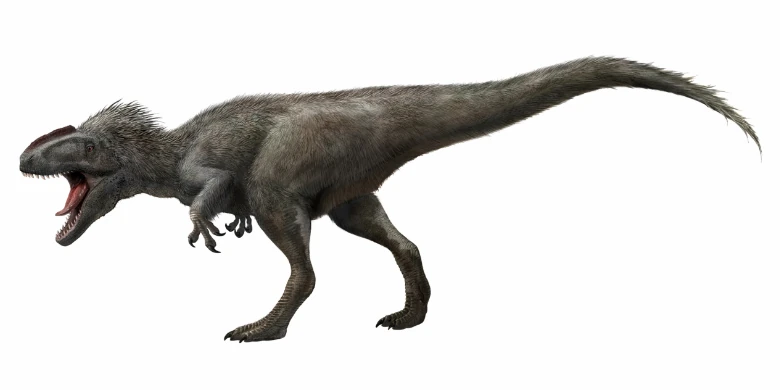The Caudipteryx living at AAI. goes by the name of Chen, and when asked to describe himself, he is quoted for saying, “Well, firstly, I'm quite flattered that you'd be doing a special newspaper article about me, I'm poorly known. Anyways, I'm a Caudipteryx, as you already know. I'm a species of bird that's been found in Cretaceous China.” I asked why he was so poorly known. His response was. “Frankly, I'm not sure. Most extinct creatures aren't very well-known in the public eye. They only usually get famous if they've been in a movie or two. I mean, take Velociraptors. Before 1993, most people wouldn't have a clue what a raptor was. But after the movie Jurassic Park was made, based on the Jurassic Park Incident of the same year, Velociraptor is almost as famous as T. rex!”
Chen said that even though his species hasn't appeared in practically any movies, he is famous for being one of the first feathered “dinosaurs” found. “It's crazy,” he says, “evolutionists so anxious to prove their theory that dinosaurs evolved into birds believe that I am a feathered theropod (carnivorous) dinosaur!” So I asked Chen what the truth about his identification is. “Well, I'm actually a bird. See, in order for the theory of dino-to-bird evolution to be true, evolutionists believe they only need feathered dinosaurs to prove their theory. Therefore, any bird that has any similarity to dinosaurs is regarded as a transitional form. This is what Archaeopteryx – a true bird – is famous for: being the much-needed transitional form between dinosaurs and birds.” But Chen explained that his species really isn't good evidence that dinosaurs evolved into birds because according to evolutionists, Caudipteryx lived in the early Cretaceous Period, long after the first birds were around! “Even Archaeopteryx is a problem for evolutionists,” Chen says. “Evolutionists believe that Archaeopteryx – a true bird – lived in the late Jurassic Period, before the bird-like dinosaurs that supposedly evolved into birds. In fact, the earliest in the dino-to-bird evolutionary line (according to evolutionists) was a dinosaur that lived at the same time as Archaeopteryx with no confirmed evidence for the presence of feathers on it.” In closing of the topic of dino-to-bird evolution, Chen is quoted for saying, “Whatever evolutionists try to make of me, I am a unique species of bird, with a mosaic of non-transitional features. I have fully-formed feathers, a toothed beak and clawed wings. Other birds that aren't claimed to be transitional forms also have these features.”
I decided to question Chen upon the subject of his diet. “Well, I'm an omnivore,” says Chen. “Here at AAI. I eat a mixture of fruits, nuts and insects. Chef Rack-Coon fixes some of the best fruit and insect salads in the entire tri-state area! Here's an interesting tidbit about me: I may have teeth, but they're useless for chewing. So I'm designed to swallow small stones. The stones – called gastroliths – sit in my stomach, rolling around in order to grind up my food.”
Daniel couldn't help but inquire about Chen's feathers and whether or not he could fly. “No, I don't fly,” said Chen. “My wings are too short to get my body off the ground for long. Evolutionists love this fact, because to them, I'm still practically a dinosaur since I can't fly. But in truth, many modern birds are flightless, such as the ostrich (which, I might add, also bears clawed wings, but no one considers them missing links!). My feathers are able to keep me aloft long enough some extended leaping. My species also uses them for impressing the females. Unfortunately, Dr. Steve hasn't cloned any other Caudipteryx yet. I should talk to him about that...anyway, these feathers are also really wonderful for busting some moves. When trying to attract a date, male Caudipteryx would often dance, flashing around their feathers in a brilliant display. They're also good at dancing at other times of the year too, check these moves out!” Then Chen demonstrated some of his dance moves. He waves his wings around in the air while lifting his beautiful tail (which has a feather-fan on the end). He also bobs his head and leaps into the air while performing his dance. I don't know about you, but I think he's pretty good at dancing.
So there you have it; now you know a little bit about the beautiful Caudipteryx, a unique species of ancient bird that also knows how to dance. In closing, Chen said, “I may not be the proof that dinosaurs evolved into birds that evolutionists are looking for (and thank goodness I'm not!), but I am still a wonderfully designed bird, fearfully and wonderfully made, by God Himself, our loving Creator!”
Written by: Mr. Smiley
Photographer: Daniel P. Smithwater
Edited by: Christian Ryan
Weekly Cartoon
Next Issue: Ligers Born at Riverville Zoo!





